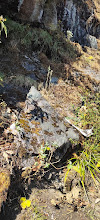Darchen
Goenpa, a beautiful edifice atop a hill amidst the thick forest under Khamdang gewog in Trashi Yangtse offers a wide range of nature, culture and history like
any other. The trek to little known site passes through broadleaved forest of
pines and oaks. The journey takes around 30 to 45 minutes uphill walk at
relaxed pace from end road point at Kanjur Lhakhang.
Legend
has it that Ani Chorten Zangmo, daughter of Tamzhing Choeje Tenzin Chogyal and
granddaughter of Terton Pema Lingpa first sanctified and blessed the place as
her summer residence. Ani Chorten Zangmo excessively traveled between Darchen
and Shakshing and later in 16th century she built a temple at
Darchen. According to the oral narratives by caretaker of the temple, the name ‘Dhar’
is derived from a rock resembling prayer flags and ‘Chen’ meaning leopard.
What
makes the site more profound is the presence of numerous sacred objects either
in cluster or scattered around the Lhakhang. Even to this day pilgrims could
see foot imprints of Ani Chorten Zangmo and Darchen Kasung, imprints of
Dakini’s pudendum, feast offering bowl, white conch (male & female),
Zambala (male and female), Zhithro lhatsho, Guru’s Zhugthri and Guru Druphu
where self-arisen dragon is visible on the rock. The cave also holds many
imprints and treasures of various religious figures. People of Tongzhang are
affluent in livestock farming because of revered object; Zambala in Darchen facing
towards Tongzhang. Locals visit the place to receive blessing from the object particularly
to prosper in livestock farming.
Just few kilometers from the temple, there are two lakes shrugged in thick broadleaved forest. One is Yabtsho Karpo, which is said have shifted to Gangkhar village under Trashi Yangtse gewog owing to ill treatment by people and animals. Not so long after its disappearance, the lake has however returned to Darchen. Yumtsho Marmo is located below the temple aside the pathway towards Darchen. It is a beautiful spectacle of both the lakes that rests in dense forest, pristine and calm yet it appears so dreadful.














